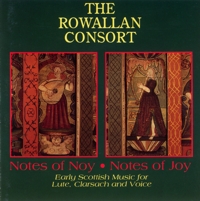Sleeve
Notes
The Rowallan Consort
'Notes of Noy; Notes of Joy'
Early Scottish Music
for Lute, Clarsach & Voice
'Harpe and fethill both they fande,
Getterne and als so the swatrye;
Lutte, and rybybe, both gangande,
And all manner of mynstralsye.'
Thomas
of Ercyldune(1219-99)
'......to heare the sweet and delicate voice
of cunning singers, intermedled with
the melodious sound of lutes, cirters,
clairshoes,or other quiet instruments of that kind.'
Alexander
Hume (1556-1609)
These two quotations tell us much about
the lute and clarsach in Scotland. Firstly, and to some most surprisingly,
the lute has been known in Scotland since the 13th century. Whether
arriving via returned crusaders or visiting continental noblemen,
it was instantly accepted and became an integral part of the Scottish
chamber ensemble for a further 400 years. Secondly, when the lute
is mentioned, the harp or clarsach is never far away.
From the household accounts of the Lord
High Treasurers of Scotland we find the following, typical of many
such accounts documenting payments to Musicians:
1507. Jan 1. item, that day giffen to divers
minstrales schawmeris, trumpetis taubroneris, fitheralis, luteris,
harparis, clarsacharis, piparis, extending to lxix persons...x.li.xi.s.
Here we should note the distinction between
'harparis' and 'clarcharis'. Too often in our own time the one
implies the other. In 1507 the harp referred to was probably the
Lowland gut-strung harp; the clarsach was used in the Highlands
and Ireland and was strung with brass wire. They were clearly two
different instruments, and were played with two different techniques,
the gut strings being played with finger pads and finger nails
being required to pluck the brass strings. However, they obviously
existed side by side, and with the lute and 'other quiet instruments
of that kind', joined in a mixed consort of the type described
by Gawain Douglass (d. 1522) in the 'Palace of Honour' as a sound
of 'soft releschingis in dulce deliverning'.
Early Scottish music cannot be classified
in terms of simply 'classical' or 'folk' music. In past times,
music in Scotland fell into three categories-'notes of noy'(sadness);
'notes of joy'; and 'sleep music'. Lutaris and clarsaris would
have been familiar with all three. The music recorded here is a
cross section of many such instances that involved the lute and
clarsach. The lute manuscripts are the obvious starting point.
The complete Scottish lute repertoire runs to some 400 pieces.
Many are settings of clarsach, fiddle or pipe tunes popular all
over Scotland on the 16th and 17th centuries and contain the earliest
settings of such classic airs as 'Grein Greus ye Rasses' and 'The
Flowers of the Forrest'. The Golden Age of the lute in Scotland,
however, had all but vanished by this time, and, sadly, because
of the Reformation and a self-exiled Court, almost nothing survives
it. But by looking at musical performance practice in other European
courts at this time, especially the French, with whom Scotland
shared an 'auld alliance', one can get a picture of what might
have taken place.
Robert Phillips
William Taylor
Music Notes
(A) Two songs
To open this recording we have two of the most popular Scottish
songs of the early 17th century.
(B) Five pieces from the Straloch lute
manuscript (1627-29)
This selection begins and ends with a popular Spanish dance from
the Canary Islands, although it must be said that these 'canaries'
have a distinctly Scottish plume! The solo clarsach version of 'I
long for thy 'virginitie' is an arrangement from the Skene manuscript
of c.1630.'A Port' is a musical form peculiar to Scotland, found
mainly in the repertoire of clarsairs. The 'Daunce: Green Greus
ye Rasses' appears in its earliest known form.
(C) Three pieces by Robert Johnson (c.1500-c.1560)
One of Scotland's finest renaissance musicians, Robert Johnson
fled the early reforming zealots in Scotland to be given employment
in the English court of Henry VIII. 'Defiled is my name' is a
poem written, as legend tells us, by Anne Boleyn on the night
before her execution.
(D) The Lady Louthian's Lilte
Three different versions of the tune, as found in Robert Edwards
'Commonplace Book (c.1630-65), the straloch lute manuscript and
the Skene mandour manuscript, arranged for solo clarsach. Although
appearing with variant spellings in the different manuscripts
('Louthian' and Laudian'). William Dauny suggests that the tune
was in honour of Lady Lothian, spouse of Mark Kerr, Commendator
of Newbattle, who was created Earl of Lothian in 1606, and died
in 1609.
(E) Four songs from the Wode part-books
Although written as four-part vocal pieces, Scottish lutars would
have followed the fashion of their continental counterparts and
arranged or 'intabulated' three of the four parts into a lute
accompaniment to the one remaining voice, in this instance the
soprano. Often these songs betray a French influence, possibly
originating there and being newly set to original Scottish poems.
(F) Three instrumental pieces
Although written in a mainstream European style, these pieces nonetheless
display Scottish traits. Melodic leaps, distinctive rhythm and
unusual phrase lengths all speak of a uniquely developed culture.
(G) Three Scottish lute pieces
The first two are from the Rowallan lute book (c.1612-28) providing
the inspiration behind the name 'The Rowallan Consort'. 'Gypsies
Lilt' is a very unusual work, centred around a weird and highly
emotional chord. If there is one piece that separates Scottish
lute music from all other English and continental lute music
then this is it. 'Come Yards' is an improvisation upon the 'double
tonic' chord progression, again typically Scottish. The third,
untitled, piece is found in an English manuscript originally
belonging to a lutenist of James I of England (as the coat-of-arms
on the cover describes him). Obviously in 1603 by a Scottish
lutar to the king.
Sources
(A) Elliot/Shire(eds), Music of Scotland.1500-1700; Musica Britannica,
vol.,XV, Stainer and Bell, London,1975.
(B) Straloch MS, 1627-29, NLS Adv.5,2,18; Skene MS, c.1680,NLS
Adv.5.2.12.
(C) As for (A).
(D) Robert Edwards Commonplace Book, 1630-65, NLS Pan11; Straloch
lute manuscript; Skene mandour book.
(E) Wode part-books, 1562-1615, Edinburgh University Library.
(F) As for (A)
(G) Rowallan lute manuscript, 1612-28, Edinburgh University Library,
Laing III. 487; Jane Pickering lute book, c. 1616, facsimile pub.
Boethius Press. |
 This
venture into Scottish early music is a first for Temple Records
- the label known mainly for its emphasis on traditional Scottish
music. It is also the recording debut for The Rowallan Consort.
Formed in 1994 by Robert Phillips and William Taylor, they uniquely
combine the sound of the lute and the wire-strung harp (clarsach)
to beautiful effect. With guest singers Mhairi Lawson and Paul
Rendall, they have researched and perform songs and music
dating from 1400-1700.
This
venture into Scottish early music is a first for Temple Records
- the label known mainly for its emphasis on traditional Scottish
music. It is also the recording debut for The Rowallan Consort.
Formed in 1994 by Robert Phillips and William Taylor, they uniquely
combine the sound of the lute and the wire-strung harp (clarsach)
to beautiful effect. With guest singers Mhairi Lawson and Paul
Rendall, they have researched and perform songs and music
dating from 1400-1700.  Robert
Philips is recognised as Scotland’s foremost lutar
and is in demand by many ensembles. Specialising in the Scottish
lute repertoire, he has performed the fruits of his research
on radio and in concert throughout Scotland. Determined to revitalise
the Scottish lute, he has initiated a lute course at Napier University
in Edinburgh and gives workshops and performance lectures in
schools and colleges. To this end, he has published "Music
for the Lute in Scotland" (Kinmore Music) which includes
pieces in tablature and transcription, along with an essay on
the history of the lute in Scotland.
Robert
Philips is recognised as Scotland’s foremost lutar
and is in demand by many ensembles. Specialising in the Scottish
lute repertoire, he has performed the fruits of his research
on radio and in concert throughout Scotland. Determined to revitalise
the Scottish lute, he has initiated a lute course at Napier University
in Edinburgh and gives workshops and performance lectures in
schools and colleges. To this end, he has published "Music
for the Lute in Scotland" (Kinmore Music) which includes
pieces in tablature and transcription, along with an essay on
the history of the lute in Scotland. Robert
& William are joined for this recording by two young Scottish
singers of growing international stature - Mhairi Lawson and Paul
Rendall. Recent TV and radio broadcasts have brought Mhairi
Lawson to the fore, along with concerts in Europe, the
USA and Canada. A recent recording of Haydn songs with Russian
fortepianist Olga Tverskaya has been released on Opus III.
Robert
& William are joined for this recording by two young Scottish
singers of growing international stature - Mhairi Lawson and Paul
Rendall. Recent TV and radio broadcasts have brought Mhairi
Lawson to the fore, along with concerts in Europe, the
USA and Canada. A recent recording of Haydn songs with Russian
fortepianist Olga Tverskaya has been released on Opus III. Paul
Rendall, a native Orcadian, performs regularly with
the Scottish vocal group Capella Nova, and in many other ensembles
both on Scotland and abroad. He has studied early vocal technique
with James Bowman, the King's Consort and Catherine Mackintosh.
Paul
Rendall, a native Orcadian, performs regularly with
the Scottish vocal group Capella Nova, and in many other ensembles
both on Scotland and abroad. He has studied early vocal technique
with James Bowman, the King's Consort and Catherine Mackintosh.